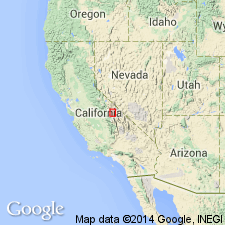
- Usage in publication:
-
- Tinemaha granodiorite*
- Modifications:
-
- Named
- Dominant lithology:
-
- Granodiorite
- AAPG geologic province:
-
- Sierra Nevada province
Summary:
Pg. 1529-1530. Tinemaha granodiorite. Commonly porphyritic and contains subhedral to anhedral grains of perthite up to 1.5 cm across; some specimens equigranular or seriate. Outcrop area in south half of Big Pine 15-min quadrangle is about 32 square miles. Intruded by Lamarck Granodiorite (new), granodiorite of McMurry Meadows, and quartz monzonite similar to Cathedral Peak Granite. Intrusive relations with Inconsolable Granodiorite (new) not determined. Age is Cretaceous.
Type locality: in cirques at head of Tinemaha Creek [Lat. 37 deg. 02 min. N., Long. 118 deg. 26 min. W., Big Pine 15-min quadrangle (Split Mountain 7.5-min quadrangle) Inyo Co., CA], east-central Sierra Nevada, near Bishop. Named from Mount Tinemaha.
Source: US geologic names lexicon (USGS Bull. 1350, p. 762); supplemental information from GNU records (USGS DDS-6; Menlo GNULEX).
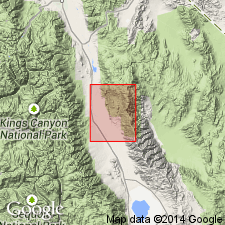
- Usage in publication:
-
- Tinemaha Granodiorite*
- Modifications:
-
- Age modified
- AAPG geologic province:
-
- Sierra Nevada province
Summary:
Santa Rita pluton of Tinemaha Granodiorite described as medium-grained, nonfoliated, in part composed of porphyritic quartz monzonite. Tinemaha previously assigned to Cretaceous on basis of zircon and biotite ages (Bateman, 1961, p. 1527). Mineral ages of Santa Rita pluton of Tinemaha Granodiorite in Inyo Mountains of both Jurassic and Cretaceous ages suggest broader range in age of Tinemaha Granodiorite. Age is Jurassic or Cretaceous.
Source: GNU records (USGS DDS-6; Menlo GNULEX).
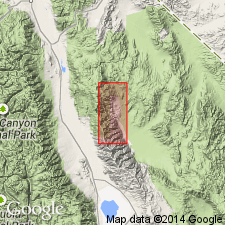
- Usage in publication:
-
- Tinemaha Granodiorite*
- Modifications:
-
- Geochronologic dating
- Age modified
- AAPG geologic province:
-
- Sierra Nevada province
Summary:
Mapped in Big Pine, Mount Pinchot and Independence 15-min quadrangles on map of granitic rocks of Inyo Mountains. In Mount Pinchot quadrangle, Woods Lake mass (12 sq mi elongate pluton) has been assigned to Tinemaha Granodiorite (Moore, 1963, p. 77, pl. 1). Santa Rita Flat pluton of Tinemaha Granodiorite (located in Independence 15-min quadrangle) occurs typically as reddish-brown-stained hummocky outcrops and boulder piles. In fresh exposures constituents give rock medium-gray to medium-dark-gray color. Most distinctive is subhedral hornblende crystals as long as 20 mm. K-Ar age determination of 156 +/-5 Ma on hornblende from Santa Rita Flat pluton indicate Early Jurassic age. Therefore age of Tinemaha Granodiorite changed from Jurassic or Cretaceous --to-- Early Jurassic.
Source: GNU records (USGS DDS-6; Menlo GNULEX).
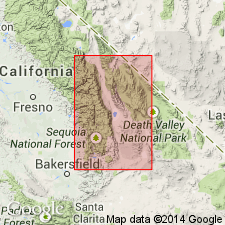
- Usage in publication:
-
- Tinemaha Granodiorite*
- Modifications:
-
- Geochronologic dating
- AAPG geologic province:
-
- Sierra Nevada province
Summary:
Woods Lake mass of Tinemaha Granodiorite sample located at Lat. 36 deg. 47.1 min. N., Long. 118 deg. 18.9 min. W., yielded concordant U-Pb age of 164 Ma.
Source: GNU records (USGS DDS-6; Menlo GNULEX).
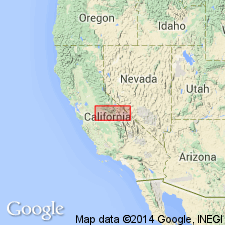
- Usage in publication:
-
- Tinemaha Granodiorite*
- Modifications:
-
- Geochronologic dating
- AAPG geologic province:
-
- Sierra Nevada province
Summary:
Sample 55 of Tinemaha Granodiorite (location shown on map) has Pb-U-Th isotopic ages of 162.9 to 145.0 Ma.
Source: GNU records (USGS DDS-6; Menlo GNULEX).
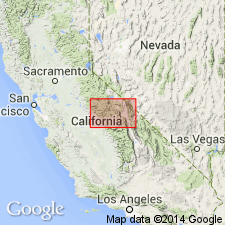
- Usage in publication:
-
- Tinemaha Granodiorite*
- Modifications:
-
- Revised
- Age modified
- AAPG geologic province:
-
- Sierra Nevada province
Summary:
Included in Palisade Crest Intrusive Suite (new). Described as weakly megacrystic to seriate biotite-hornblende granodiorite and hornblende-biotite granite. In western lobe is more felsic inward from western margin. Is intruded by granodiorite of McMurry Meadows, leucogranites of Red Mountain Creek and Taboose Creek, Lamarck Granodiorite, Inconsolable Quartz Monzodiorite (formerly Inconsolable Granodiorite of Bateman, 1965), and leucogranite of Rawson Creek. Has U-Pb ages of 155 Ma (Stern and others, 1981) and 164 Ma (Chen and Moore, [1979]). 164 Ma is concordant and approximates true age. Age is changed to Middle Jurassic.
Source: GNU records (USGS DDS-6; Menlo GNULEX).
For more information, please contact Nancy Stamm, Geologic Names Committee Secretary.
Asterisk (*) indicates published by U.S. Geological Survey authors.
"No current usage" (†) implies that a name has been abandoned or has fallen into disuse. Former usage and, if known, replacement name given in parentheses ( ).
Slash (/) indicates name conflicts with nomenclatural guidelines (CSN, 1933; ACSN, 1961, 1970; NACSN, 1983, 2005, 2021). May be explained within brackets ([ ]).

